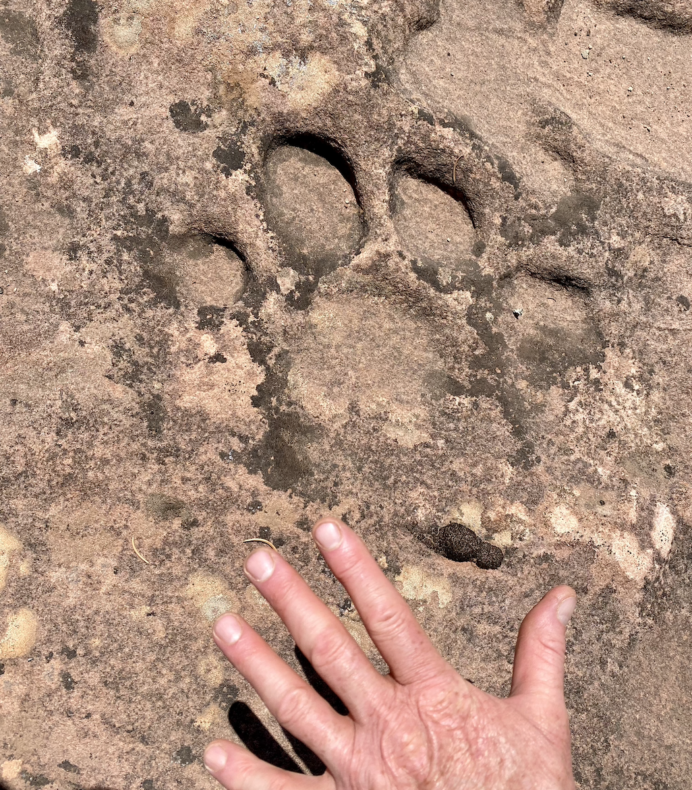
I took this picture the other day, and I have to admit, it’s a trick. For half a second, I thought I’d made some impossible discovery, the track of what looks to be a giant cat in ancient sandstone.
With all the prehistoric tracks appearing lately — Ice Age humans in Utah, sloths in New Mexico, dinosaurs in Texas — I’ve had my eye to the ground. The picture I took is of Jurassic sandstone. It resembles a cat track, the size of a Pleistocene species, a 500-700 pound feline. Rounded pads, no claw marks, that’s what I’d call it. But felines are Oligocene in origin, 25 million years ago, certainly not Jurassic, which would have been of dinosaur age. So, what is it?
As some might have guessed, it’s not animal at all. The picture is of solution pockets naturally formed in sandstone, and they happened to erode this way. You can tell by the lichens grown on these ‘prints’ that this is a rock surface, and not mud squished between the toes of a cat the size of a grizzly walking around in a mid-latitude dune sea in the days of the dinosaurs.
In the Southwest, ancient images have been pecked into stone, ancestral markers of early Native America. The images of spirals, hunts, and birthing scenes could be understood as historical documents, a record of creation legends, who moved where and when, a bible written in stone a thousand or more years ago. Some of the human figures you see pecked into boulders or cliffs have tails. This harkens to a telling that at the start of time people were not fully formed, still aqueous in nature, fingers webbed, tails still attached. The earth is said to have been soft in those days, which would explain dinosaur tracks. An ancient being could place a hand or foot on rock and the impression would remain.
On the windy pans of White Sands in southern New Mexico, researchers found tracks of a giant Ice Age sloth where it had walked the muddy shore of a Pleistocene lake. Inside those tracks are the footprints of a person following it. The date is 21,000 years ago, until recently considered a farfetched age for humans in North America.
On a dried Ice Age lakebed in Utah, researchers announced last month the find of 88 human footprints from children to adults, carbon material in and around them dating about 12,000 years old.
Meanwhile, a drought stricken river in Texas dried up this summer, revealing a deeply-set trackway of a three-toed carnivorous dinosaur from the Early Cretaceous.
I adhere to the legend of the once soft world. Sea floors, shorelines, and deltas can attest. It’s not soft all at the same time in the same places, but a juggling act throughout the planet’s history. From the fossil record, our progenitors had tails, as evolutionary evidence shows. We left signs of ourselves, every kind of animal and plant, and the legend hasn’t ended. The world is still soft and our tracks are being pressed into it, every footprint we put on the ground a potential story to be told thousands or millions of years from now.
The faux-track I photographed is a geologic sign, not an animal one. Water and minerals concentrated underground, changing the composition of the rock when it was still sediment. As the feature is brought to the surface in a hardened sandstone, it weathers differentially, showing patterns of how water once moved and settled.
We live among nothing but tracks, one footprint set inside the next. The mountain range is a track of tectonic subduction. Rivers are tracks of melting snow. We are in an echo chamber of prints. Look to the ground, they are everywhere.
Photo: Craig Childs
These droughts and glacial meltings that are causing such angst among some people are fascinating. What was buried under the ice or submerged as the ice melted is revealing so much about how our planet changes and obscured the past. Instead of being fearful, I am inspired by these hints from the past that should have been ground into dust or dissolved.